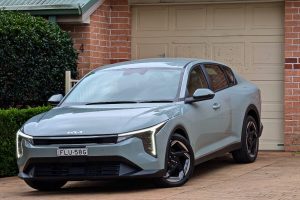Chris Riley tests the 2025 Kia K4 Sport+ small sedan with pricing, specs, ride and handling, safety, verdict and everything the over-50 driver needs to know.
Summary: The outgoing Cerato was a popular choice for Kia buyers, and the new K4 improves on it in almost every area. Local ride and handling tuning makes it feel right for Australian conditions.
2025 Kia K4 Sport+ small sedan
Pricing: $40,990 (driveaway)
Options: premium paint price not yet announced
Warranty: Seven-years, unlimited km, up to seven-years capped price servicing
Safety: Not tested
Engine: 2.0-litre naturally aspirated four-cylinder petrol engine
Service intervals: 12 months or 15,000km
Power: 112kW @ 6200rpm
Torque: 192Nm @ 4000rpm
Transmission: six-speed auto, front-wheel drive
Body: 4710mm (long); 1850mm (wide); 1425mm (high)
Build country: South Korea
Kerb weight: 1355kg
Towing capacity: 1100kg
Luggage storage: 508L
Wheels: 17-inch alloy
Tyres: 225/45 R17
Spare wheel: steel space saver
Turning circle: 10.7m
Fuel tank: 47 litres
Claimed consumption: 7.4L/100km (91 RON unleaded)
Consumption on test: 6.4L/100km (470km)
seniordriveraus consumption on test: not tested
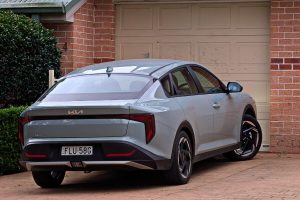
[review]
The futuristic-looking K4 is a replacement for the Kia Cerato.
But, for the time being at least, both are offered for sale by the South Korean car manufacturer.
At this stage we get the sedan but not the hatch which will probably turn up later in the year.
Kia says the change of name brings the K4 into line with the rest of the world, where it has already adopted the same naming strategy: K3 (Kia Rio), K5 (Optima) and K8 (Cadenza) and K9 (K900).
Only the tiny Picanto remains wearing its old name.
At a time when many car manufacturers are dumping sedans, it is interesting to note that Kia has chosen to continue with the K4, which like the Cerato is a larger small car – but this time at a higher price.

What’s it cost?
K4 comes in five grades, priced from $30,590.
There’s the entry-level K4 S ($30,590), K4 S with Safety Pack ($32,690), K4 Sport ($35,190), K4 Sport+ ($37,590) and K4 GT-Line ($42,990).
They mirror Cerato grades but cost more; in the case of GT-Line, $6130 more.
Clear White is the only colour that doesn’t cost xtra.
Our test vehicle, the K4 Sport+ costs $5380 more than the Cerato it replaces.
K4 embraces Kia’s latest design language with bold, sporty lines and sleek, fastback style, with a lower roofline and lower beltline than its predecessor.
Inspired by Kia’s ‘Opposites United’ design philosophy, it employs vertical front headlights and daytime running lights at the outer edges to accentuate the wide stance.
K4 also incorporates Kia’s signature ‘Star-Map’ front and rear lighting graphics to align with the brand’s latest ‘Tiger Face’ styling.
Concealed rear door handles, integrated into the C-pillars, reinforce the coupe appearance, while black wheel arch cladding and wheels ranging in size from 16 to 18-inch add to the sporty stance.
From the back, K4 exudes a powerful presence punctuated by vertical tail lights and longer overhangs, plus a raked rear windscreen and air diffuser on GT-Line.
Sport+ is kitted out with 17-inch alloys, artificial leather upholstery, two-zone climate air with rear vents, solar shield glass windscreen, heated front seats, six-way power driver seat adjustment, smart key with remote and push-button start, adaptive cruise control, traffic sign recognition, intelligent speed limit assist, auto high beam, auto lights and wipers, auto-dimming rear view mirror, front and rear parking sensors and heated, power-folding exterior mirrors.
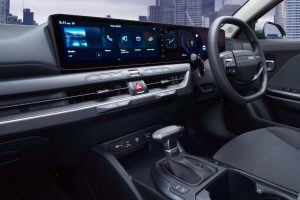
In this model a sweeping dashboard display incorporates a 12.3-inch infotainment screen and second 12.3-inch digital instrument cluster, separated by a 5.0-inch climate screen – all housed within the one assembly.
Infotainment includes personalised user profiles, Bluetooth, satellite navigation, AM/FM and DAB+ digital radio, Sounds of Nature background noise, wireless and wired CarPlay and Android Auto, plus six-speaker audio.
GT-Line adds a Harman Kardon eight-speaker system.
The system also supports over-the-air updates and Kia Connect telematics, including auto SOS call, control some functions, vehicle status monitoring and you can even send an address directly from the app to the vehicle navigation system.
There are four USB-C outlets, two in front and another two in the back, plus a 12-volt outlet in the front, but only GT-Line offers wireless phone charging.
Access is complimentary for the duration of the warranty.
The car is yet to be tested and receive a crash rating from the ANCAP organisation, but comes with a full suite of safety systems.
All models get seven airbags, a reversing camera with dynamic guidelines and all-important automatic emergency braking (AEB).
Standard are Forward Collision-Avoidance Assist (FCA), Smart Cruise Control (SCC) with Stop & Go functionality, Lane Keep Assist (LKA), Lane Follow Assist (LFA), Multi-Collision Braking (MCB), Blind-Spot Collision-Avoidance Assist (BCA), Driver Attention Warning (DAW), Intelligent Speed Limit Assist (ISLA), Rear View Monitor (RVM) and High Beam Assist (HBA).
The Safety Pack adds Junction Turning and Crossing plus Direct/Oncoming Lane Change Detection functionality.
Sport+ ups the ante with Kia’s latest Highway Driving Assist 2, with stop-and-go capability, combining with Lane Following Assist (LFA) to keep K4 centred in the lane even when driving through a curve, while HDA 2 adds Lane Change Assist (LCA), allowing the K4 to autonomously change lanes when the required conditions are met.
There are three child seat tethers and two ISOFix anchor points.
K4 is covered by the company’s seven-year unlimited kilometre warranty together with seven years of capped price servicing and roadside assistance.
The warranty period for Connected Services however does not restart on transfer of vehicle ownership.
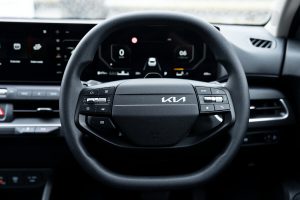
What’s it go like?
The new, five-seat sedan is more rigid and with reduced noise, vibration and harshness thanks to the use of high-strength steel and reinforced sound insulation.
K4 measures 4710mm long, 1850mm wide and 1425mm high, with a 2720mm wheelbase.
Inside, those dimensions convert to more space, especially with respect to rear legroom which has grown by 56mm.
Front seat occupants benefit from increased head and shoulder room.
Additionally, K4 boasts an increase in boot space over its predecessor, with the sedan offering 508-litres (a lot more with the rear seat backs folded forward).
The spare is a steel space saver.
K4 embraces Kia’s ongoing efforts in sustainability, incorporating the use of the brand’s 10 ‘must-have’ sustainability items, including PP and Bio PE plastic, Post Consumer Material (PCM), Bio PU Leather, Bio PU foam, Bio Paint, BTX-free Paint, Recycled PET Yarns, and Recycled PET Felt.
S, Sport and Sport+ are all powered by a carry-over 2.0-litre naturally aspirated four-cylinder engine, together with a six-speed automatic transmission, that develops 112kW of power and 192Nm of torque, and uses a claimed 7.4L/100km.
GT-Line scores a more powerful 1.6-litre turbocharged unit and a CVT-based eight-speed auto, that generates 142kW and 264Nm, with consumption rated at 6.7L/100km.
One wonders why a self-charging hybrid is not offered, but that would obviously bump up already inflated prices.
With a 47-litre tank, both engines take standard unleaded and we averaged 6.4L/100km after 470km of mixed driving in a week.
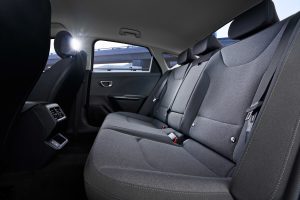
There are three drive modes from which to choose: Sport, Normal or Eco to suit your driving preferences.
GT-Line also gets beefier brakes and a more sophisticated rear suspension setup.
Six years ago, I praised the then Cerato Sport for its performance.
Although fitted with the same 2.0-litre engine as the K4, there was nothing dull or lifeless about the naturally aspirated engine.
“It’s a willing worker that likes to rev and even produces a healthy note when you’re really going for it,” I wrote back in 2019.
The same holds good for the current K4 Sport+ that we drove recently.
Ride and handling are particularly well-sorted, thanks to Kia’s local tuning program.
But the drive experience is somewhat spoiled by a down-market, polyurethane steering wheel that becomes irksome over time.
You’ll read a lot of reviews urging punters to skip this model and put their money into the turbocharged GT-Line, even if it does carry a $5400 premium.
But most of them are written by privileged young blokes who have become used to driving top-spec models and crave the extra power they bring.
Older, less demanding buyers are more easily satisfied.
At this end of the market that is a huge difference in price and one that many buyers will simply not be able to afford.
Yes, the turbo is quicker. Yes, the turbo is better for overtaking. And yes, the turbo even uses less bloody fuel.
However, a reality check reveals the Sport+ is still a nice bit of kit.
What we like
- Stinger inspired looks
- Comfortable and easy to drive
- Plenty of rear legroom
- Doesn’t use much fuel
What we don’t like
- Concealed rear door handles
- Lacks paddle shift gear changers
- All the safety gear is not standard
- Polyurethane steering wheel rough on hands
What over-50s need to know
K4 is a better car than the Cerato, but the Cerato sold on price and value for money.
The extra cost of the K4 could see it slip from favour if Kia is not careful.
As the saying goes: if it ain’t broke, don’t fix it (and it ain’t).
Older buyers will like the fact it is a sedan and one that is comfortable, easy to drive and good on gas, but might find the futuristic styling a bit off-putting.
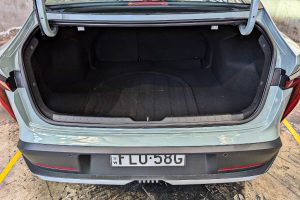
senior driver comments
Sedans have been losing popularity for some time now, and the Cerato replacement looks like it will come out in hatchback form later in the year. There is also some talk that a hybrid version is in the wings. If either of these options is appealing, it may pay to wait until later in the year before placing your order. But if you’re happy with a sedan-only, petrol-only choice, go for it.
The Cerato replacement has taken a fair hit in the value department, although it does feature a number of equipment and tech upgrades to offset the price increase. And it is still, despite the increase, one of the cheaper vehicles in the segment. In price terms, it sits pretty much alongside the Hyundai i30 sedan, despite the Kia having more recent tech.
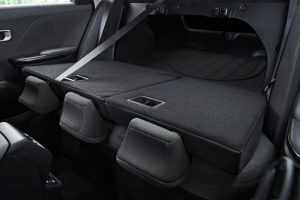
The pared back design gives the impression of more space than there really is. Plenty of the fittings have been borrowed from more upmarket Kias (and that’s hardly a bad thing) but there are still too many hard plastics at touch points.
Once, again, the overspeed warning can be truly frustrating (you can mute it at the start of each journey) but it will still beep at you when speed limits change, and when it detects you not looking ahead (even if you are!)

